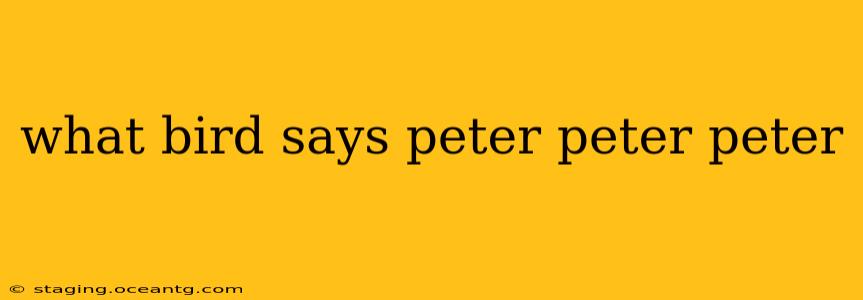What Bird Says "Peter, Peter, Peter"?
The bird that famously says "Peter, Peter, Peter" is the Eastern Whip-poor-will. While it doesn't actually say the name "Peter," its distinctive call is often transcribed phonetically as "whip-poor-will," and many people, particularly in areas where the bird is common, interpret parts of its call as sounding like "Peter, Peter, Peter."
This common misinterpretation highlights the fascinating way humans interpret animal sounds and apply meaning to them. The Eastern Whip-poor-will's actual call is a complex series of notes, and the "Peter, Peter, Peter" interpretation is a subjective and localized one. The bird's call is crucial for its communication and mating rituals, serving a very different purpose than simply mimicking a human name.
What other sounds does the Eastern Whip-poor-will make?
The Eastern Whip-poor-will's vocalizations are varied, and go beyond the simple "whip-poor-will." It utilizes a range of sounds including:
- The "whip-poor-will" call: This is its most famous call, a series of notes that often sound like a mournful, repetitive song.
- A "chuckling" sound: This shorter, more rapid series of notes is also part of its communication repertoire.
- Other variations: The exact sounds can vary depending on the individual bird and the situation (e.g., mating calls, territorial defense).
Understanding the nuances of these sounds requires careful observation and listening in their natural habitat.
Are there other birds whose calls sound similar to "Peter, Peter, Peter"?
While the Eastern Whip-poor-will is the most commonly associated bird with this sound due to the phonetic similarities, it's important to note that no other bird has a call consistently described as "Peter, Peter, Peter." The similarity is often a matter of subjective interpretation of the sounds. Many bird calls can sound like different things depending on the listener and background noise, contributing to the potential confusion.
How can I identify an Eastern Whip-poor-will?
Identifying an Eastern Whip-poor-will requires careful observation, as they are nocturnal and crepuscular birds (active at dawn and dusk). Key identifying features include:
- Nocturnal behavior: They are primarily active at night.
- Tawny brown plumage: Their camouflage coloration helps them blend seamlessly into their environment.
- Large eyes: Adapted for low-light conditions.
- Distinctive call: The "whip-poor-will" call, while subjective in interpretation, is a crucial identifier.
The best approach to identification is through a combination of their characteristic call, careful observation in their natural habitat (typically forests and woodlands), and potentially using bird identification resources such as field guides or bird-watching apps.
What is the best time of year to hear the Eastern Whip-poor-will?
The best time to hear the Eastern Whip-poor-will's calls is during the breeding season, typically from spring through summer. This is when they are most active and vocal, communicating and establishing territories. However, depending on the region, you might hear them calling into early autumn as well.
By combining a detailed understanding of its calls, physical characteristics, and active periods, identifying the Eastern Whip-poor-will and understanding the origin of the “Peter, Peter, Peter” association becomes clearer. Remember, bird identification is often about more than just a single sound; it's about combining multiple clues for a complete picture.
